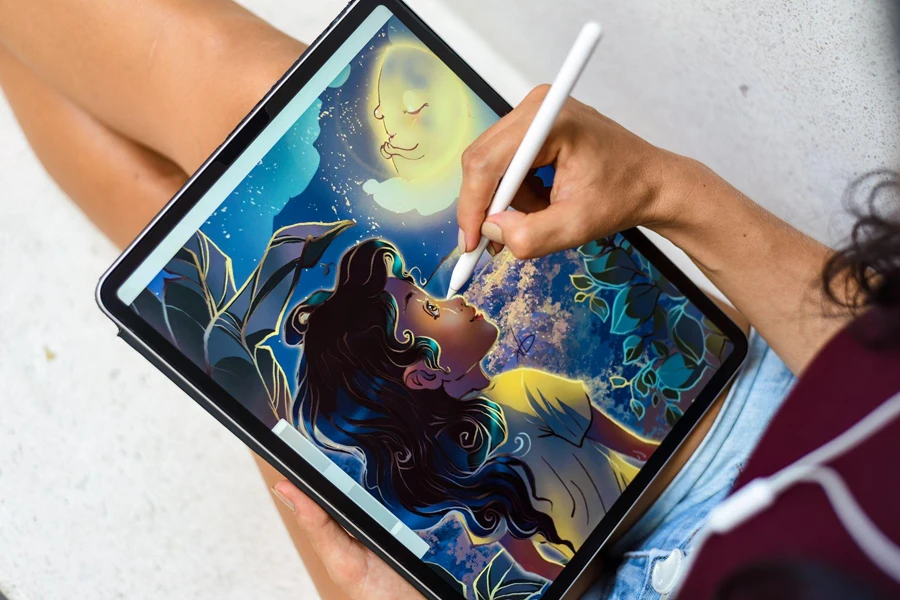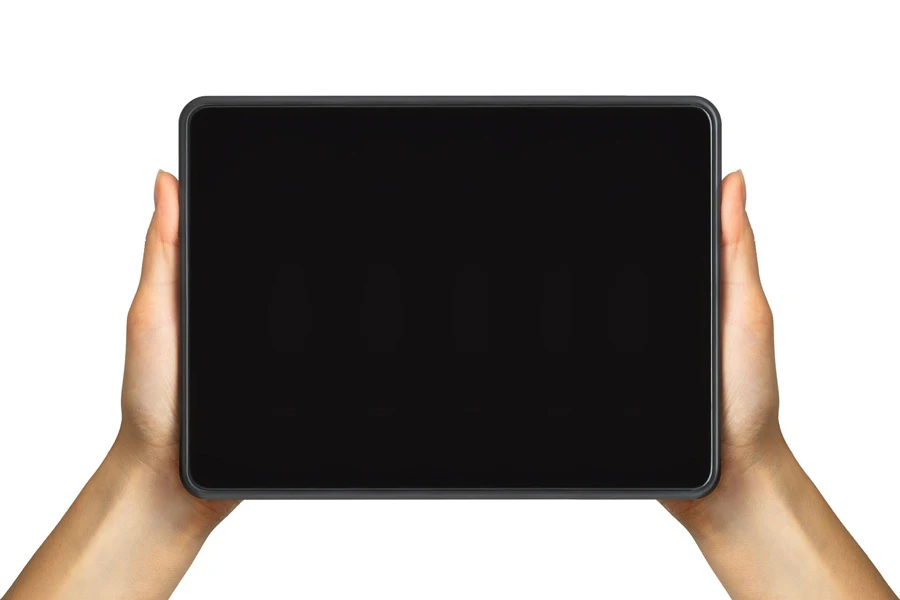Graphics tablets have become essential tools in the creative industry, revolutionizing how artists, designers, and illustrators work. These devices offer a digital canvas that mimics the feel of traditional drawing, allowing for precise control and flexibility. From sketching and painting to photo editing and 3D modeling, graphics tablets enhance productivity and creativity by providing intuitive interfaces and high-resolution displays. The right graphics tablet can significantly improve the quality of work and streamline creative processes. With various types available, selecting the most suitable model is crucial for achieving optimal performance and meeting specific professional needs.
Table of Contents
1. Types and uses of graphics tablets
2. Current market overview
3. Key considerations for selecting graphics tablets
4. Leading models and their features
5. Conclusion
Types and uses of graphics tablets

Pen displays
Pen displays are graphics tablets with built-in screens that allow artists to draw directly on the display. This feature provides a natural drawing experience, similar to traditional pen and paper. The main advantage of pen displays is their high-resolution screens, which offer superior color accuracy and detail. This makes them ideal for tasks requiring precision, such as digital illustration, animation, and photo editing.
Professional applications of pen displays are vast. They are frequently used in animation studios for storyboarding and character design. For instance, the Wacom Cintiq Pro 24, with its 4K resolution and 99% Adobe RGB color coverage, is a favorite among industry professionals for its reliability and high-quality display. Artists appreciate the intuitive interface and the pen-to-screen feel, which enhances their creative workflow. Moreover, pen displays are valuable in fields like graphic design and architectural visualization, where accurate representation of colors and details is crucial.
Pen tablets
Pen tablets, unlike pen displays, do not have built-in screens. Instead, they are connected to an external monitor where the artist can see their work. These tablets are often more affordable and portable, making them a practical choice for artists who need a robust and reliable tool without the high cost of a display screen.
Pen tablets are widely used in various creative fields. They are ideal for illustrators and designers who require precise control over their work. The Xencelabs Pen Tablet, for example, offers a comfortable drawing surface with customizable keys that enhance productivity. These tablets are also popular among digital painters and concept artists who need a dependable tool that can handle detailed work. Additionally, pen tablets are frequently used in education, where art students can benefit from learning digital techniques on a cost-effective device.
General-use tablets
General-use tablets, such as the iPad Pro and Microsoft Surface Pro, are versatile devices that serve multiple purposes beyond drawing. These tablets are equipped with high-resolution screens and support for stylus pens, making them suitable for digital art. However, their functionality extends to general computing tasks, web browsing, and media consumption.
The versatility of general-use tablets is a significant advantage. Artists can use them for sketching and drawing, while also benefiting from their portability and multi-functionality. The iPad Pro, with its powerful M1 chip and Liquid Retina XDR display, is an excellent choice for artists who need a portable yet capable device. It supports a wide range of creative apps and offers a smooth drawing experience with the Apple Pencil. Similarly, the Microsoft Surface Pro combines the power of a laptop with the convenience of a tablet, making it ideal for professionals who require a device for both creative and general tasks.
General-use tablets are not only used by individual artists but also in collaborative environments. Design teams can leverage these devices for brainstorming sessions, presentations, and quick edits on the go. The ability to switch seamlessly between different applications and tasks makes general-use tablets a valuable addition to any creative professional’s toolkit.
In summary, understanding the types and uses of graphics tablets is essential for making an informed decision. Pen displays offer unparalleled precision and are ideal for professional applications that require high-quality visuals. Pen tablets provide a cost-effective and portable solution for artists who need reliable performance without a built-in screen. General-use tablets combine versatility with advanced drawing capabilities, making them suitable for both creative and general tasks. Selecting the right type of graphics tablet depends on the specific needs and preferences of the user, as well as the intended application within the creative industry.
Current market overview

Market trends in 2024
The graphics tablet market in 2024 is characterized by several significant trends driven by advancements in technology and changing user demands. One of the most notable developments is the enhancement of display technologies. Tablets now feature higher resolutions, such as 4K and even 5K, with improved color accuracy and wider color gamuts. These advancements cater to professionals who require precise and vibrant displays for detailed work. For instance, models like the Wacom Cintiq Pro 24 and the Xencelabs Pen Display 24 are celebrated for their exceptional display qualities.
Another trend is the integration of more advanced pen technologies. Tablets are now equipped with pens that offer higher levels of pressure sensitivity, often exceeding 8,192 levels, and improved tilt recognition. These features enhance the drawing experience by providing more natural and responsive pen strokes. The XPPen Artist Pro 16, for example, boasts 16,000 levels of pressure sensitivity, making it a standout option for professionals who demand precision.
The market is also seeing a rise in hybrid devices that combine the functionalities of a traditional computer with those of a graphics tablet. Devices like the Huion Kamvas Studio 16, which operates on a full Windows OS, exemplify this trend. Such tablets offer versatility, allowing users to switch between creative tasks and general computing seamlessly.
In terms of market growth, the graphics tablet industry continues to expand. Experts currently value the graphics tablet market at USD 1.42 billion and expect it to reach USD 2.09 billion by 2028. They estimate this boost will happen at a compound annual growth rate (CAGR) of 6.7% from 2023 to 2028. Key players such as Wacom, Huion, and XP-Pen hold significant market shares, driven by continuous innovation and a strong focus on meeting the needs of creative professionals.
Industry demand and adoption
The demand for graphics tablets is robust across various creative sectors. In the animation industry, tablets like the Wacom Cintiq series are essential tools for storyboarding and character design. These tablets offer the precision and reliability needed for professional-grade animation work. Similarly, in graphic design and digital illustration, high-resolution pen displays are indispensable for creating detailed and intricate artworks.
The adoption of graphics tablets is also increasing in the fields of photography and video editing. Tablets with high color accuracy and responsive pen inputs enable photographers to perform precise photo retouching and manipulation. Video editors use these tablets to create detailed frame-by-frame edits, enhancing the overall production quality.
Several factors are driving the adoption of graphics tablets among professionals and hobbyists alike. The increasing accessibility of advanced tablets, coupled with their affordability, has made them more attractive to a broader audience. Additionally, the integration of tablets with popular creative software like Adobe Photoshop, Clip Studio Paint, and other industry-standard applications enhances their appeal. These software packages often offer specialized tools and features that are optimized for use with graphics tablets, further driving their adoption.
The versatility of general-use tablets such as the iPad Pro has also contributed to the growing demand. These tablets are not only powerful creative tools but also serve multiple functions, making them a practical choice for users who need a device that can handle both professional and personal tasks. The compatibility of these tablets with a wide range of creative apps adds to their utility, making them popular among both professionals and enthusiasts.
Moreover, the rise of remote work and online collaboration has increased the demand for digital tools that facilitate creative work from any location. Graphics tablets, with their portability and connectivity options, are well-suited to meet these needs. They allow artists to collaborate on projects in real time, regardless of their physical location, making them essential tools in the modern creative workflow.
The graphics tablet market in 2024 is marked by technological advancements, growing market size, and increasing adoption across various creative sectors. The continuous innovation by key players and the expanding use cases for these devices underscore their importance in the creative industry. As technology evolves, graphics tablets will continue to be indispensable tools for artists, designers, and other creative professionals.
Key considerations for selecting graphics tablets

Display quality and resolution
Display quality and resolution are paramount when selecting a graphics tablet, as they directly impact the clarity and accuracy of the work produced. High-resolution screens, such as 4K or even 5K, provide a more detailed and crisp image, essential for tasks that require precision. The Wacom Cintiq Pro 24, for instance, offers a stunning 4K resolution with 99% Adobe RGB coverage, ensuring vibrant and accurate color reproduction. This level of detail is crucial for professionals in digital illustration, animation, and photo editing, where every pixel counts.
Another example is the Xencelabs Pen Display 24, which also boasts a 4K resolution and an IPS panel that provides excellent viewing angles and consistent color accuracy. These features are essential for designers who need to ensure their work looks consistent across different displays. Additionally, the iPad Pro’s Liquid Retina XDR display combines high resolution with advanced technologies like ProMotion and True Tone, offering a smooth and adaptive viewing experience. This versatility makes it a favorite among artists who need a portable yet powerful device.
Pressure sensitivity and pen performance
Pressure sensitivity and pen performance are critical factors that influence the drawing experience on a graphics tablet. Higher levels of pressure sensitivity allow for more nuanced and precise control over brush strokes, mimicking the feel of traditional drawing tools. The XPPen Artist Pro 16, for example, offers an impressive 16,000 levels of pressure sensitivity, providing artists with the ability to make fine adjustments and create detailed work.
Pen technology has also advanced significantly, with features like tilt recognition and improved latency becoming standard. These enhancements ensure that the pen responds naturally to the artist’s movements, offering a more intuitive and seamless drawing experience. The Wacom Pro Pen 2, used in the Cintiq Pro series, is renowned for its responsiveness and accuracy, with 8,192 levels of pressure sensitivity and virtually no lag. This pen’s ability to detect tilt and varying pressure levels accurately replicates the experience of using traditional art tools, which is invaluable for detailed and expressive work.
Compatibility and software support
Compatibility with popular creative software is another crucial consideration. Graphics tablets must seamlessly integrate with industry-standard applications like Adobe Photoshop, Clip Studio Paint, and others. Reliable driver and software support are essential to ensure that the tablet functions correctly and receives updates that enhance performance and compatibility.
For instance, the Huion Kamvas series offers excellent compatibility with a range of software, providing users with flexibility in their workflows. Regular updates and robust driver support further enhance the tablet’s performance, reducing the risk of compatibility issues. The iPad Pro, running on iPadOS, supports a wide variety of creative apps and offers a user-friendly interface, making it a versatile tool for both professional and hobbyist artists. Additionally, the Wacom Cintiq line is known for its seamless integration with creative software, ensuring that artists can fully leverage the features of their preferred programs.
Portability and ergonomics
Portability and ergonomics play significant roles, especially for artists who work in various environments or need to carry their tools with them. Tablets like the iPad Pro and Microsoft Surface Pro are known for their portability, combining lightweight designs with powerful hardware. These devices are perfect for artists who need to work on the go, offering the flexibility to create anywhere.
Ergonomics is equally important, as prolonged use of graphics tablets can lead to strain or discomfort. Models with adjustable stands, like the Wacom Cintiq Pro and the Xencelabs Pen Display, allow users to find the most comfortable drawing angle. Additionally, tablets with well-designed, ergonomic pens reduce hand fatigue, enabling artists to work longer without discomfort. The Wacom Ergo Stand, for example, is specifically designed to provide a range of ergonomic positions, reducing strain during long working sessions.
Price and value for money
Price and value for money are critical considerations, particularly for businesses looking to equip their teams with the best tools without overspending. The market offers a wide range of options, from high-end models like the Wacom Cintiq series, known for their premium features and reliability, to more affordable options like the XPPen Artist Pro, which provides excellent performance at a lower price point.
Analyzing pricing trends, it’s evident that while high-end models offer superior features, mid-range tablets like the Huion Kamvas series provide a good balance of performance and cost. These tablets are ideal for professionals seeking high-quality tools without the premium price tag. The versatility and robust features of general-use tablets like the iPad Pro also offer great value, combining creative capabilities with everyday functionality. For instance, the iPad Pro starts at around $999, but its multi-functionality makes it a cost-effective option for those who need both a powerful creative tool and a general-use tablet.
Choosing the right graphics tablet involves considering various factors, including display quality, pressure sensitivity, compatibility, portability, and price. By evaluating these aspects and understanding the specific needs of the intended application, businesses can ensure they select the best tools to enhance productivity and creativity in their teams.
Leading models and their features

Wacom Cintiq Pro 24
The Wacom Cintiq Pro 24 stands out as a premier choice for professional artists and designers, offering an impressive array of features that enhance creative workflows. This graphics tablet features a 23.6-inch 4K display with a resolution of 3840 x 2160 pixels, delivering stunning clarity and detail. The 99% Adobe RGB color gamut ensures vibrant and accurate color reproduction, crucial for high-end digital art, photo editing, and animation.
The Cintiq Pro 24 is equipped with the Wacom Pro Pen 2, which offers 8,192 levels of pressure sensitivity, tilt recognition, and virtually no lag. This pen provides a natural and responsive drawing experience, closely mimicking traditional art tools. The tablet also includes customizable ExpressKeys, a Touch Ring, and multi-touch gestures, allowing artists to streamline their workflow and increase productivity. Users and experts alike praise the Cintiq Pro 24 for its robust build quality and reliability, making it a long-term investment for serious professionals.
Xencelabs Pen Display 24
The Xencelabs Pen Display 24 is a formidable competitor in the market, known for its exceptional performance and value. This 24-inch tablet features a 4K resolution display, providing sharp and detailed visuals. The IPS panel ensures consistent color accuracy and wide viewing angles, essential for professional work. The tablet supports 8,192 levels of pressure sensitivity and includes a well-designed pen that offers a smooth and responsive drawing experience.
The Xencelabs Pen Display 24 stands out with its ergonomic design and user-friendly features. It comes with an adjustable stand that allows users to find the most comfortable drawing angle, reducing strain during long working sessions. The tablet also includes customizable shortcut keys and a Dial, which can be programmed for various functions, enhancing the creative process. Compared to other leading models, the Xencelabs Pen Display 24 provides a balance of high-quality display, excellent pen performance, and thoughtful design, making it a valuable tool for digital artists and designers.
XPPen Artist Pro 16 (2nd Gen)
The XPPen Artist Pro 16 (2nd Gen) is an affordable yet powerful option for digital artists, providing a balance between performance and cost. It features a 2.5K QHD resolution (2560 x 1440 pixels) on a 15.6-inch display, offering sharp and clear visuals. The tablet provides 16,000 levels of pressure sensitivity, ensuring precise control over brush strokes and line thickness, which is exceptional for its price range.
This model is particularly noted for its affordability without compromising on key features. It includes a pen with tilt recognition and customizable shortcut keys that enhance productivity. The compact size of the Artist Pro 16 makes it a great choice for artists who need a portable device without sacrificing performance. Specific use cases where this model excels include digital illustration, concept art, and 3D modeling. The XPPen Artist Pro 16 (2nd Gen) is highly recommended for students and professionals looking for an affordable, high-quality graphics tablet.
iPad Pro 12.9-inch (2022)
The iPad Pro 12.9-inch (2022) is a versatile device that combines advanced features suitable for both creative professionals and general use. It boasts a Liquid Retina XDR display with a resolution of 2732 x 2048 pixels, providing exceptional brightness and color accuracy. The display supports ProMotion technology, delivering a smooth and responsive drawing experience with the Apple Pencil 2.
One of the key advantages of the iPad Pro is its versatility. In addition to being a powerful drawing tablet, it functions as a high-performance tablet for everyday tasks. The M1 chip ensures fast and efficient performance across a wide range of applications, from graphic design software to video editing tools. Situations where the iPad Pro outperforms dedicated graphics tablets include its portability, battery life, and multi-functionality. For artists who need a device that can handle both creative work and general computing tasks, the iPad Pro is an ideal choice. Its ability to run a wide range of creative apps, coupled with its portability and powerful performance, makes it a popular choice among professionals and hobbyists alike.
Huion Kamvas Studio 16
The Huion Kamvas Studio 16 offers an all-in-one solution for digital artists by combining the functionality of a Windows PC with the capabilities of a graphics tablet. It features a 15.6-inch display with a 2.5K resolution (2560 x 1440 pixels), providing detailed and vibrant visuals. The tablet supports 8,192 levels of pressure sensitivity and includes a responsive pen that offers a natural drawing experience.
This model is particularly well-suited for artists who need an integrated solution for both drawing and general computing tasks. The Kamvas Studio 16 runs on a full Windows OS, allowing users to install and use any software they need without the limitations of a traditional tablet. It includes built-in speakers and a range of connectivity options, making it a versatile tool for creative professionals. The all-in-one capabilities and robust performance of the Huion Kamvas Studio 16 make it an excellent choice for artists who want a powerful and flexible device for their creative and computing needs.
Conclusion
Choosing the right graphics tablet is crucial for optimizing productivity and creativity in any professional setting. Key considerations include display quality, pressure sensitivity, compatibility with software, portability, and overall value for money. Top models like the Wacom Cintiq Pro 24 and the Xencelabs Pen Display 24 offer exceptional performance, while options like the XPPen Artist Pro 16 and Huion Kamvas Studio 16 provide excellent features at more affordable prices. By carefully evaluating specific needs and budget constraints, businesses can make informed decisions, ensuring their teams have the best tools to succeed.




